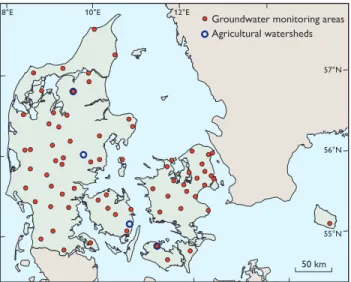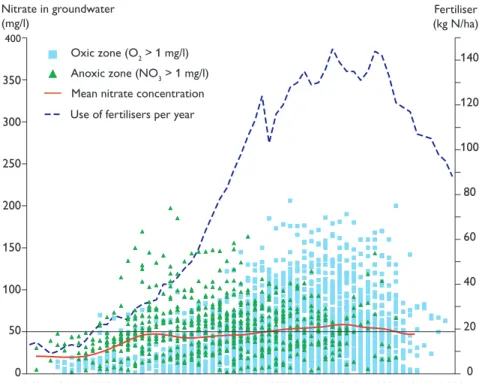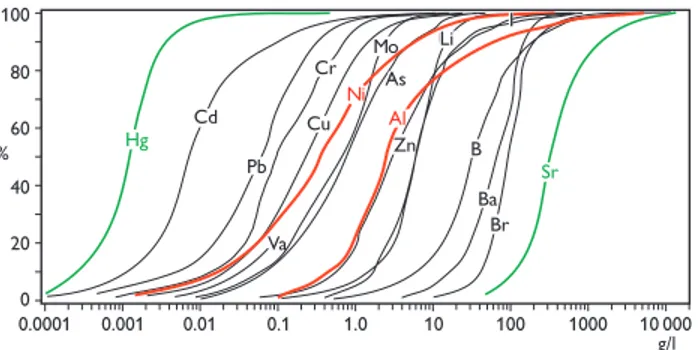As the drinking water supply in Denmark is totally based on groundwater, monitoring of the groundwater quality is ex-tremely important to the Danish community. With more than 62% of the total land area under agricultural use the Danish Government has determined that the entire area is vulnerable to nitrate polution, and therefore the groundwa-ter monitoring programme should cover the entire country.
The Danish groundwater monitoring programme com-prises water supply well monitoring, the groundwater moni-toring network and agricultural watershed monimoni-toring (Figs 1, 2) and is described on www.groundwater.dk. The pro-gramme is part of the National Action Propro-gramme for the Water Environment and Nature, NOVANA (Svendsen & Norup 2004; Svendsen et al. 2005).
Groundwater quality monitoring is carried out on the basis of data from approximately 6200 public water supply wells. Furthermore, a detailed analytical programme is car-ried out on 1415 well screens from the monitoring network comprising 70 catchment areas, and on 100 shallow screens from the five agricultural watersheds (Svendsen et al. 2005).
The detailed quality monitoring includes analyses for 97 chemical elements, comprising 26 main elements, 14 heavy metals, 23 organic micro-pollutants and 34 pesticides and metabolites.
Nitrate
The water supply wells generally have long screens and are intended to provide representative information on the distri-bution of the nitrate content in primary groundwater reser-voirs. Data from water extraction wells are, however, biased since the wells are intended to ensure production of drinking water with nitrate concentrations below the maximum admissible concentration (MAC) of 50 mg nitrate per litre.
The groundwater monitoring wells give a more accurate picture of the general nitrate pollution in the Danish ground-water. In 1998–2004, mean nitrate concentrations were above the MAC limit for drinking water in 16.9% of the wells, whereas about 60% had no nitrate (< 1 mg nitrate per litre).
The spatial distribution of nitrate in the groundwater aquifers varies. West of the Weichselian glaciation borderline (Fig. 1), the outwash plains are dominated by upper, uncon-fined aquifers overlying deeper, conuncon-fined Quaternary and Miocene sands. East of the glaciation borderline the sandy
meltwater deposits and the pre-Quaternary limestone aqui-fers are generally covered by clayey till which reduces or pre-vents nitrate pollution (Fig. 3).
Over the past half century the use of fertilisers in farming has intensified dramatically (Fig. 4). Groundwater from the monitoring screens has been dated using the CFC (chloro-fluorocarbon) content (GEUS 2004), and demonstrates that the highest nitrate values reflect the increase in the use of fer-tilisers (Fig. 4). Continued monitoring will show whether the decrease in the use of fertilisers during the last decade will result in a decrease in the nitrate content, or whether the increasing use of manure will maintain high nitrate levels. Preliminary data suggest, however, that since 1979 farmers have adapted their spreading practice for fertilisers and manure such that nitrate pollution is now following a decli-ning trend.
33
Groundwater quality monitoring in Denmark
Jens Stockmarr
Geological Survey of Denmark and Greenland Bulletin 7, 33–36 (2005) © GEUS, 2005 < 35 000 35 000 – 350 000
350 000 – 3500 000 Water extraction in m3
> 3500 000
50 km
10°E 12°E
8°E 55°N 57°N
Nickel, arsenic and other inorganic trace
elements
The most widespread impact from inorganic trace elements is due to nickel derived from oxidation of pyrite, bravoite and other heavy metal bearing sulphides (Fig. 5). Massive disso-lution of sulphides occurs in areas where large-scale extrac-tion of groundwater has caused lowering of the groundwater table, followed by an influx of oxic groundwater. During dis-solution, some of the nickel is adsorbed by contemporane-ously precipitated manganese oxide. The trapped nickel is, however, released when the groundwater table rises again, since this leads to reducing conditions and dissolution of the manganese oxides.
Implementation in 2001 of the EU Drinking Water Di-rective in Danish legislation has led to increased concern with respect to arsenic, for which the MAC value was decreased from 50 to 5 µg/l. Nine per cent of the monitoring well
screens in the groundwater monitoring programme currently exceed 5 µg/l in all samples, while 14% exceed 5 µg/l in at least one sample (Fig. 6). The distribution of arsenic is to a large degree controlled by redox conditions, as the solubility of arsenic is about ten times higher in reducing environments compared to oxidising conditions. High arsenic concentra-tions are mainly found in aquifers underlying clayey sedi-ments.
As a result of seven years of groundwater monitoring, the background levels of the 23 inorganic trace elements analysed are well known and are illustrated by the cumulative curves in Fig. 7. Most curves show a regular distribution, e.g. stron-tium (Sr) and mercury (Hg), indicating little or no pollution, whereas the skewed curves for aluminium (Al) and nickel (Ni) reflect pollution.
Pesticides and metabolites
Analytical results from the water supply wells, the groundwa-ter monitoring areas and the agricultural wagroundwa-tersheds differ markedly (Fig. 8). Only agricultural pesticides were detected in water samples collected from young groundwater in the agricultural watersheds, whereas in water samples collected in the groundwater monitoring network other pesticides, such as those used in consolidated areas like urban areas, roads or farmyards have also been found. Pesticides and their metabo-lites are found in more than 25% of all wells (Table 1; GEUS 2004).
The most frequently found pesticide group consists of tria-zines and their metabolites. These compounds are commonly found in both farming and urban areas. In the agricultural watersheds the triazines and their metabolites make up about half of all recorded pesticides and metabolites.
In water supply wells the analytical data indicate a very high frequency of 2,6-dichlorobenzamide (BAM) findings. Twenty-five per cent of the wells contain BAM, and 10% have concentrations above the MAC value of 0.1 mg/l. BAM is a metabolite from dichlobenil and chlorothiamide that were commonly used prior to 1997 as a total herbicide in urban areas, along roads and in farmyards.
34
Fig. 2. Network of Danish national groundwater monitoring areas (catchments) and selected agricultural watersheds covered by the ex-tended monitoring programme. From Stockmarr & Nyegaard (2004).
12°E 10°E
8°E
55°N 56°N 57°N
50 km
Groundwater monitoring areas Agricultural watersheds
0 20 40 60 80 100%
0–10 10–20 20–30 30–40 40–50 50–60 60–70 70–80 80–90
≤ 1 mg/l NO3 1–50 mg/l NO3 > 50 mg/l NO3
Depth (
m
)
n = 894
n = 1 500
n = 1 746
n = 1 413
n = 1 050
n = 711
n = 456
n = 282
n = 149
Fig. 3. Distribution of nitrate versus depth to well screen in groundwa-ter monitoring and wagroundwa-ter supply wells. The data cover the period 1998– 2003 and are grouped into three classes according to mean nitrate. From GEUS (2004).
Pesticides and metabolites
1998–2003 Number % Number %
Number of analysed screens
Screens with findings
Findings ≥ 0.1µg/l (MAC)
Monitoring network 1020 437 42.8 153 15.0
Agricultural watersheds 75 52 69.3 19 25.3
Water supply wells 5515 1443 26.2 355 6.4
Table 1. Pesticides and metabolites in Danish groundwater
The monitoring network demonstrates high detection rates for pesticides in the upper 40–50 m of wells tested, and a lower number of findings with increasing depth (Fig. 8).
Pollution in shallow groundwater
Drinking water from 628 dug wells and shallow drilled wells used for single private supply and minor partnership supplies (less than nine families) was investigated in a research project focusing on the youngest groundwater (Brüsch et al. 2004).
In 35% of the investigated wells, pesticides and their metabo-lites were recorded with values above the MAC value for drinking water (0.1 mg per litre), whereas 11% of wells had more than ten times the MAC value.
The research project showed that nitrate pollution in 22% of the wells was above 50 mg per litre. The MAC level for bacteria was exceeded in 48% of the wells whereas 31% con-tained coliforme bacteria. In total, 68% of the private supply and minor partnership supply wells delivered undrinkable water.
Fig. 5. Occurrence of nickel in Danish water supply wells, 1998–2003. Slightly modified from GEUS (2004).
Fig. 6. Occurrence of arsenic in Danish water supply wells, 1998–2003. Slightly modified from GEUS (2004).
1940 1945 1950 1955 1960 1965 1970 1975 1980 1985 1990 1995 2000 0 20 40 60 80 100 120 140
Nitrate ingroundwater
(mg/l)
Fertiliser
(kg N/ha)
Meannitrate concentration
Use offertilisers per year
0 50 100 150 200 250 300 350 400
Oxic zone (O2 > 1 mg/l)
Anoxic zone (NO3 > 1 mg/l)
Fig. 4. Nitrate content versus CFC age of groundwater. The annual use of nitrogen fertilisers is shown for comparison. Groundwater data from the anoxic zone are corrected on the basis of sulphate con-tent. Slightly modified from GEUS (2004).
12°E 10°E
8°E
55°N 56°N 57°N
50 km
> 20 µg/l ≤ 20 µg/l
Nickel 8°E 10°E 12°E
55°N 56°N 57°N
50 km
> 5 µg/l ≤ 5 µg/l
Arsenic
36
Conclusions
During the last two decades many water supply wells have been closed due to pollution; initially this was a result of nitrate pollution, and subsequently also to pesticide pollu-tion. Nickel contamination has also closed some wells, and it is feared that arsenic will cause closure of more wells. In some cases the water supply companies have extended their pro-duction wells to greater depth instead of closing them, but often this is not a viable solution.
Due to government policy that drinking-water produc-tion should be based on pure groundwater requiring only simple treatment (aeration and iron removal), only few water supply companies have had permission to install advanced water treatment for removal of pesticides or nickel. However, more and more water supplies are expected to need advanced water treatment in the future.
Nitrate pollution is still the most serious problem because intensive agricultural practices cause leakage of nitrate into groundwater and surface water. While a series of action plans have been introduced to reduce nitrate pollution, much of the young groundwater and most of the surface water in Denmark are seriously polluted by nitrate.
References
Brüsch, W., Stockmarr, J., Kelstrup, N., von Platen-Hallermund, F. & Ro-senberg, P. 2004: Pesticidforurenet vand i små vandforsyningsanlæg. Danmarks og Grønlands Geologiske Undersøgelse Rapport 2004/9, 85 pp.
Fraters, B., Kovar, K., Willems, W.J., Stockmarr, J. & Grant, R. (eds) 2005: Monitoring effectiveness of the EU Nitrates Directive Action Pro-grammes. Results of the international MonNO3workshop, The Hague,
the Netherlands, 11–12 June, 2003. RIVM Report 680100002/2005, 290 pp.
GEUS 2004: Grundvandsovervågning 1998–2003, 48 pp. København: Danmarks og Grønlands Geologiske Undersøgelse.
Stockmarr, J. & Nyegaard, P. 2004: Nitrate in Danish groundwater. In: Razowska-Jaworek, L. & Sadurski, A. (eds): Nitrates in groundwater. International Association of Hydrogeologists, Hydrogeology, Selected Papers 5, 187–199.
Stockmarr, J., Nyegaard, P., Larsen, C.L., Felding, G. & Brüsch, W. 2002: Groundwater quality monitoring in Denmark. Third International Con-ference on Water Resources and Environment Research (ICWRER), Dresden, Germany 22–26 July, 2002, Proceedings, 165–169. Svendsen, L. & Norup, B. (eds) 2004: NOVANA. Det nationale program
for overvågning af vandmiljøet og naturen. Programbeskrivelse – del 1. Danmarks Miljøundersøgelser, Faglig rapport fra DMU 495, 45 pp. Svendsen, L.M., van der Bijl, L., Boutrup, S. & Norup, B. (eds) 2005:
NOVANA. Det nationale program for overvågning af vandmiljøet og naturen. Programbeskrivelse – del 2. Danmarks Miljøundersøgelser, Faglig rapport fra DMU 508, 128 pp.
Author’s address
Geological Survey of Denmark and Greenland, Øster Voldgade 10, DK-1350 Copenhagen K, Denmark. E-mail:sto@geus.dk
0.0001 0.001 0.01 0.1 1.0 10 100 1000 10 000
g/l As
As Cr Cr
Cu
Cu
I I Li Li
Ni
Hg
Hg
Cd Cd
B
Ba Br Br
Sr Sr Pb
Pb
As Cr
Cu
I Li Mo
Va
Zn
Hg Cd
B
Ba Br
Sr Pb
%
0 20 40 60 80 100
Al Al
Al
Fig. 7. Inorganic trace elements found in Danish monitoring wells from 1993 to 1999. The skewness of the distribution pattern in the curves for nickel (Ni) and aluminium (Al) reflects pollution. Regular distributions, as e.g. for Hg and Sr, indicate little or no pollution. Slightly modified from Stockmarr et al. (2002).
Fig. 8. Occurrence of pesticides and metabolites in water supply and groundwater monitoring wells versus depth to top of well screen, 1998– 2003 as percentage of number of screens investigated. Slightly modified from GEUS (2004).
Depth (
m
)
Findings above maximum admissible concentration
Findings
0 10 20 30 40 50 60%
0 10 20 30 40 50%
Groundwater monitoring wells Water supply wells



